
Looking for the best Edge AI monitoring platform in 2025? Here's a quick breakdown of four leading solutions, their standout features, and where they work best:
| Platform | Strengths | Limitations | Best For | Pricing Model |
|---|---|---|---|---|
| ClearBlade | Strong IoT integration, scalable | High setup costs, technical complexity | Manufacturing, Industrial IoT | Custom (based on needs) |
| Tredence Edge AI | Real-time monitoring, measurable results | Limited flexibility outside core industries | Retail, Healthcare | Fixed-price |
| New Relic | Predictive analytics, integrations | Expensive with high usage | Enterprise IT, Multi-industry | Usage-based (free tier) |
| Lumana | Advanced video monitoring | Focused on video data | Security, Surveillance-focused sectors | Dedicated team model |
Key takeaway: Choose a platform based on your industry, budget, and technical needs. Edge AI is transforming industries in 2025, offering faster processing, improved security, and lower costs. Dive into the full article to explore detailed comparisons and insights.
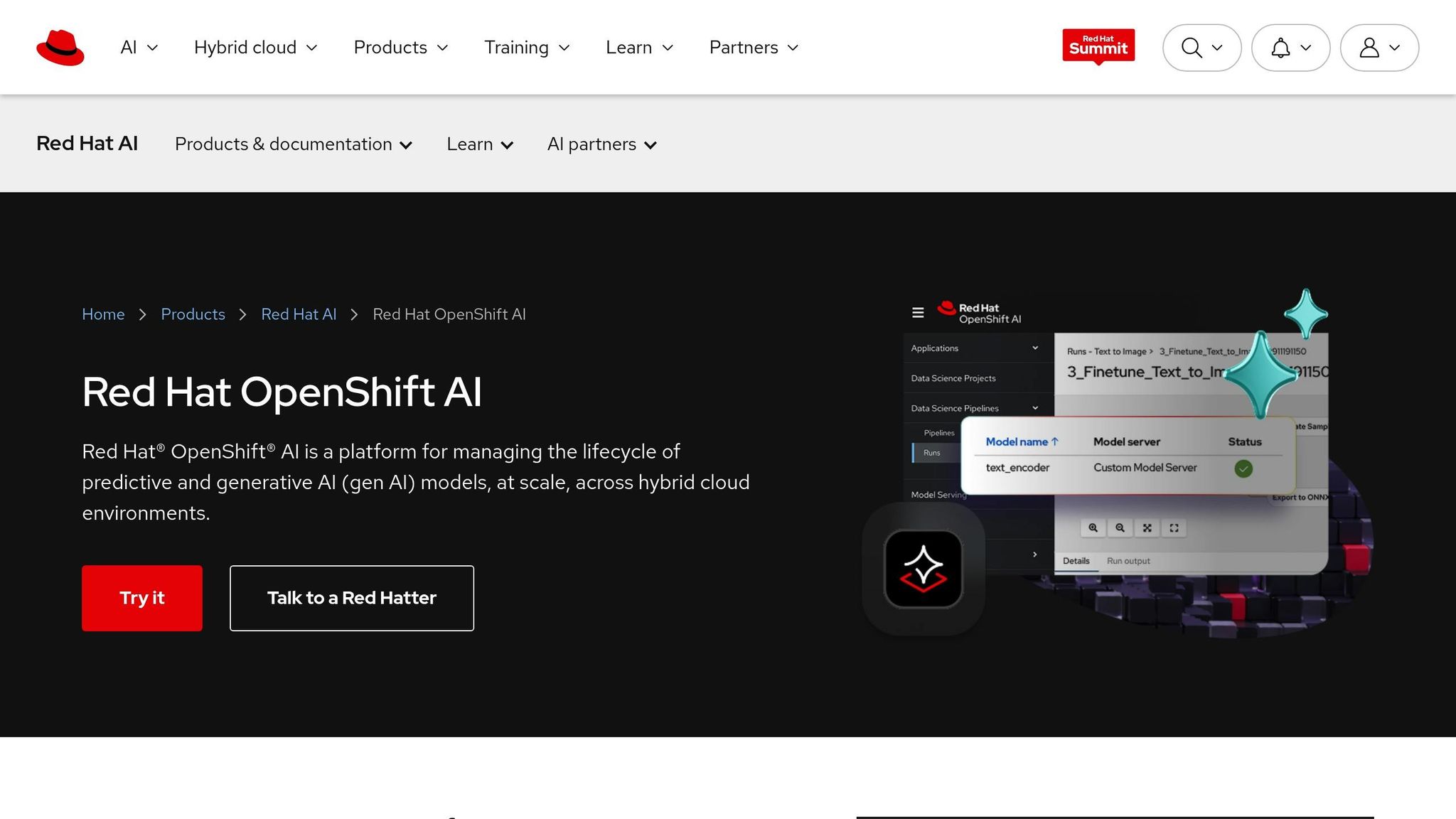
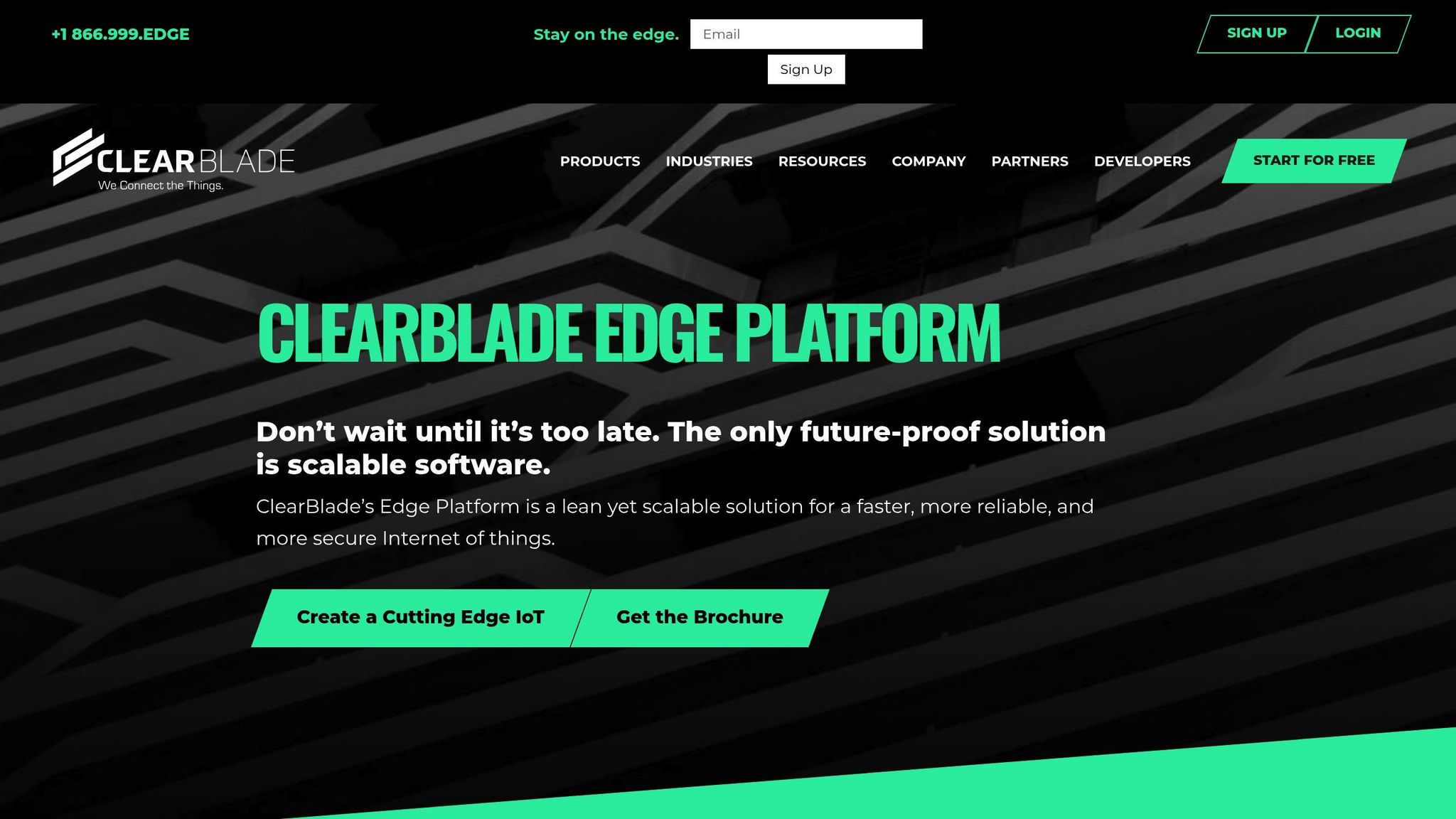
ClearBlade provides a unified system for managing both cloud and edge operations, specializing in enterprise IoT solutions since 2014. The platform is designed to handle the complexities of industrial deployments.
At the heart of ClearBlade's monitoring capabilities is its IoT Core device manager, supported by protocol bridges. These tools enable the platform to track essential metrics like active device counts, billable data usage, communication errors, and operation volumes. Metrics are aggregated at the registry level, sampled every 60 seconds, and provide near real-time insights within 180 seconds. This setup ensures constant visibility into both device performance and overall system health.
Additionally, the Enterprise Asset Monitoring solution strengthens these features by offering a centralized console for data ingestion, normalization, storage, and visualization. Users can customize alerts, generate tailored reports, and set up notifications, making it easier to monitor and respond to system changes.
ClearBlade is built to seamlessly integrate with existing enterprise systems. It supports a variety of IoT protocols and devices, including ZigBee, Bluetooth, and ZeroMQ, ensuring compatibility with a wide range of infrastructures. The platform's architecture allows for flexible deployment - whether pushing code from the cloud to the edge or developing independent edge applications to address specific operational requirements.
ClearBlade's scalability was highlighted in 2017 when it managed one million Edge Platform connections using a single Oracle Cloud Infrastructure bare metal server. Its architecture is designed for reliability, featuring redundant load balancers, horizontal clustering for rapid deployment, and efficient data access. Tools like Blade Runner, dynamic infrastructure, real-time monitoring, and detailed reporting further enhance its scalability. The platform's tiered cloud-to-edge design can handle up to 100 million devices in real time, aligning with projections of over 24 billion IoT-connected devices by 2025.
The platform's capabilities make it a strong choice for critical operations across industries such as rail, mining, facilities management, oil and gas, logistics, healthcare, energy, smart buildings, and transportation . For example, Rheem achieved a 75% reduction in delivery cycles, and Chicago Metra invested $3.9 million in edge AI/IoT solutions using ClearBlade . In water management, the platform supports remote pump control, custom event rules, and operations for Seawolf. Heritage Systems also leveraged it to monitor water quality, automate reporting, and minimize manual tasks.
ClearBlade claims to reduce development time by up to 80%, significantly lowering costs. However, pricing details are not publicly available, as the platform typically offers tailored solutions based on individual enterprise needs.
"ClearBlade was built to cut through the problems technology leaders face when developing IoT solutions for their organizations." – Eric Simone, founder and CEO, ClearBlade.
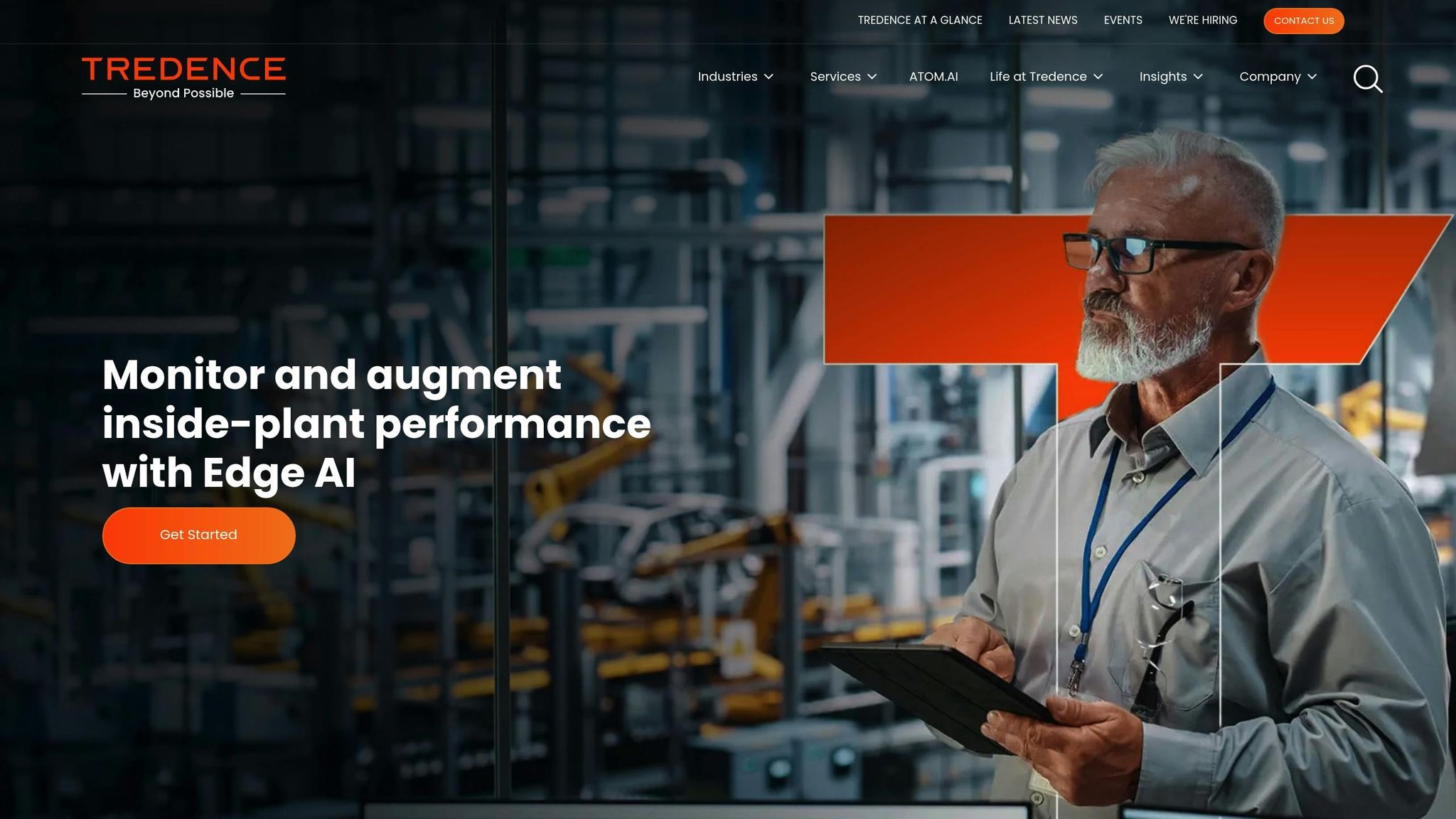
Tredence Edge AI follows in the footsteps of ClearBlade's enterprise-driven approach, offering a platform designed for real-time, collaborative monitoring of industrial operations. It focuses on giving operational teams and data scientists a shared view of AI models running on industrial equipment, ensuring these models are continuously monitored and managed. This collaboration supports the growing demand for localized, real-time intelligence in industrial settings.
The platform excels at keeping tabs on the operational performance of AI models, tracking key metrics at the edge in real time. It also simplifies the orchestration of edge devices, creating a seamless workflow between central data science teams, plant operators, and field technicians. This streamlined process helps improve efficiency across operations.
Tredence Edge AI is built to connect IoT devices and AI applications across the manufacturing value chain. Its pre-designed frameworks allow businesses to deploy edge solutions in just a few weeks, making it easier to integrate with existing enterprise systems. This setup ensures that the platform delivers fast, scalable performance with minimal delays.
The platform's architecture is designed to handle large-scale connectivity with edge devices while reducing the need for extensive physical infrastructure. Its low-latency system processes data in real time, delivering actionable insights to operators within just 2 minutes. This rapid response ensures a steady flow of data between edge devices and central systems, keeping operations running smoothly.
Tredence Edge AI shines in manufacturing environments, where its capabilities have led to impressive results. For instance, one manufacturing client saw a 23% decrease in unscheduled stoppages and a 15% reduction in wastage. Beyond manufacturing, industries like retail, healthcare, consumer packaged goods, technology, financial services, and travel also benefit from its advanced monitoring features.
In the consumer packaged goods sector, a leading company implemented Tredence's smart manufacturing solutions, while a global cement manufacturer used the platform to optimize refining processes. This resulted in 23% fewer unscheduled stoppages, a 15% drop in work-in-progress waste, and a 2% reduction in plant energy costs. These results highlight the platform’s ability to deliver measurable improvements, making it a vital tool in edge AI monitoring.
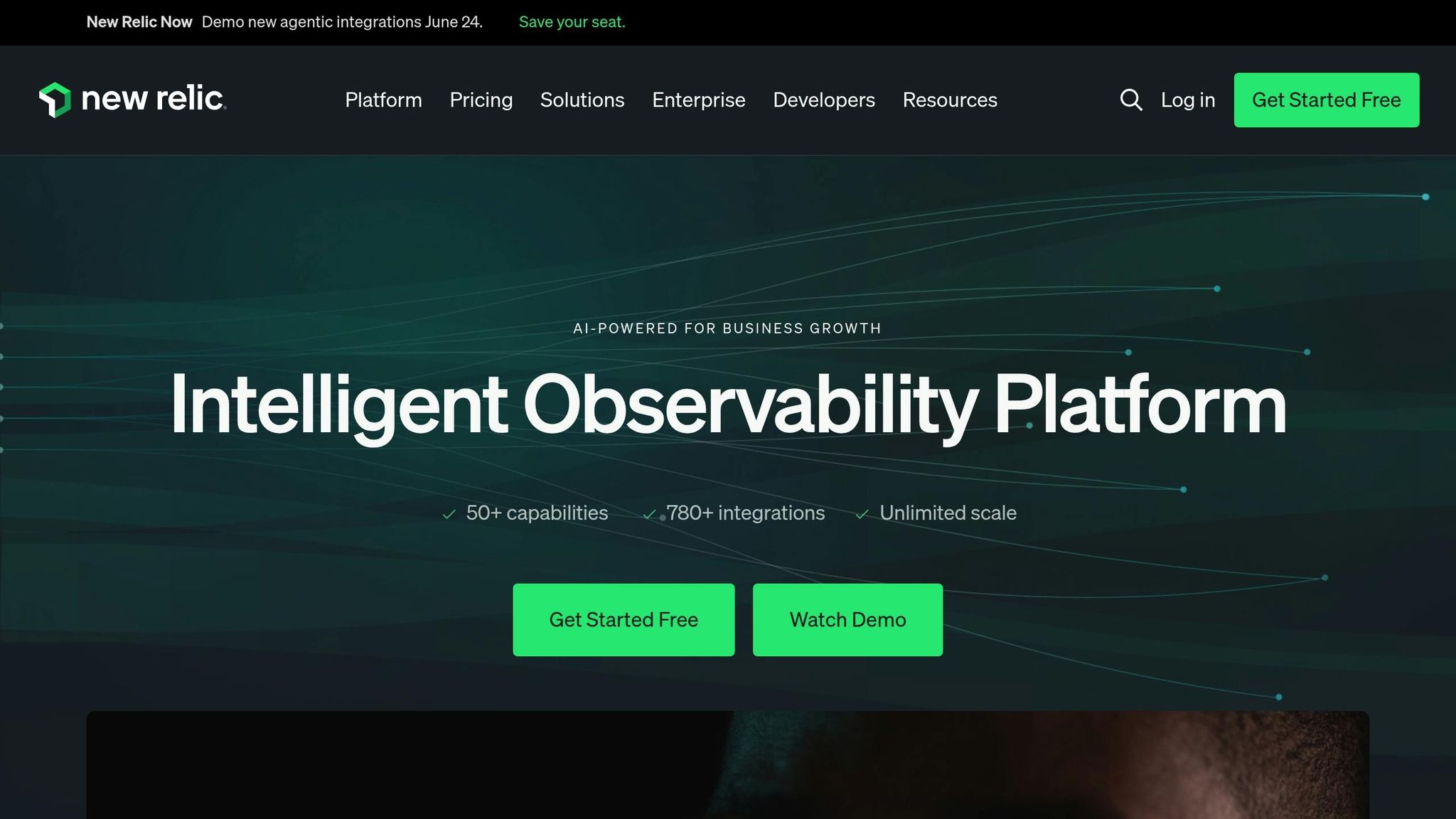
New Relic's Intelligent Observability Platform is designed to collect and monitor all telemetry data while using AI to predict and address potential issues before they arise. This proactive approach has made it a go-to solution for enterprises aiming to maintain high availability in their AI-driven systems.
The platform offers over 30 features in a single interface, providing visibility into throughput, latency, cost metrics, and business-critical transactions through integrated APM and distributed tracing. Its AI monitoring capabilities ensure full oversight of AI operations, tracking essential metrics while adhering to data privacy standards. It also maps request flows across services and models, helping teams understand how their AI applications operate.
This solid foundation is complemented by extensive integration options.
New Relic supports 780+ integrations, enabling monitoring across a wide range of tools and technologies. It works seamlessly with alerting and collaboration tools like PagerDuty, Slack, Campfire, and HipChat, ensuring important alerts reach the right teams promptly. Development teams benefit from integrations with ticketing systems like Atlassian Jira, Lighthouse, and Pivotal Tracker. Additionally, the platform is compatible with public cloud providers like AWS, Google Cloud, and Microsoft Azure, making it ideal for multi-cloud environments.
"We're able to integrate a lot of tools with New Relic, but we're also able to bring our product teams and engineers a lot closer together", says Stefan Kolesnikowicz, Principal Engineer at Achievers.
It also connects with CI/CD and DevOps platforms such as Jenkins and GitLab, streamlining workflows.
Built for enterprise-scale operations, New Relic uses a usage-based pricing model that delivers 3x the value compared to traditional host-based pricing. This approach has helped companies like Credit Sense, which reduced Mean Time to Detection by 80% while cutting AWS costs. Similarly, Vault Health has set ambitious performance goals, with VP Engineering Tommy Harke stating:
"With errors inbox, we expect our MTTR to be within 15 minutes. We want every customer to have a good experience".
Organizations using New Relic report a median ROI of 4x (295%), and 58% of organizations achieve $5 million or more in annual value from their observability investments.
This scalability and cost efficiency are reflected in its pricing models.
New Relic offers flexible pricing options with four main editions tailored to different needs:
| Edition | Data Ingestion | Primary Users | Core Users | Key Features |
|---|---|---|---|---|
| Free | 100 GB free/month | 1 included | Unlimited free | Basic monitoring, community support |
| Standard | $0.35/GB beyond free | $10 for the first user, $99 additional (max 5) | $49/user | Ticketed support, 10,000 synthetic checks |
| Pro | $0.35/GB or $0.55/GB (Data Plus) | $349/user (annual) | $49/user | 2-hour SLA, advanced features |
| Enterprise | Custom pricing | Custom pricing | $49/user | 1-hour SLA, compliance features |
Both pay-as-you-go and commitment-based billing options are available, letting businesses choose what suits their needs best. The Data Plus add-on, priced at $0.55/GB, offers extended data retention and advanced analytics for deeper insights.
"The transparency, predictability, and flexibility of New Relic pricing are hugely beneficial, and we only pay for what we use", says Joshua McLean, CIO at World Kinect.
New Relic's capabilities deliver measurable results across industries, particularly in financial services and insurance, where organizations report a median annual return of 297% on their observability investments. Its comprehensive monitoring tools meet the needs of industries requiring strict compliance and high availability.
In the media sector, Seven West Media depends on New Relic for complete operational visibility. Technology Director Scott Favelle shares:
"New Relic gives us one platform that we can look at and get a complete picture. It's absolutely crucial".
In healthcare, companies like HealthifyMe leverage New Relic to adjust system performance based on traffic patterns. VP Technology Abhijit Khasnis explains that the platform enables them to "scale our systems based on how traffic is moving, without compromising on performance, cost, or the customer experience".
Nearly half (49%) of respondents report improved system uptime, while 42% cite operational efficiency gains as key benefits of using New Relic.
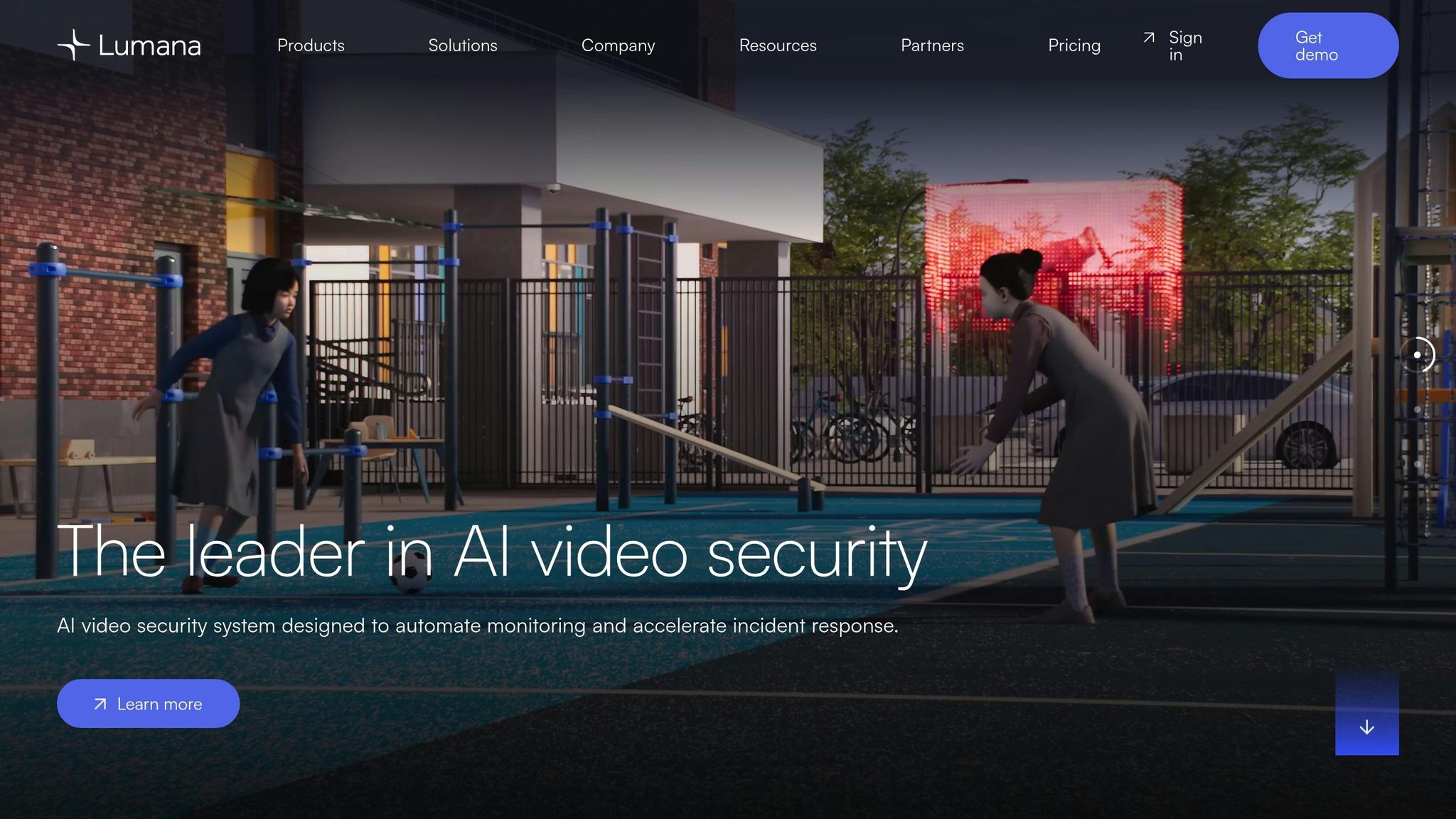
The Lumana Video Intelligence Platform turns standard IP cameras into smart, AI-powered monitoring tools. Built on a hybrid-cloud framework, it uses the Lumana Core for on-site AI processing and instant alerts while tapping into cloud resources for large-scale computing power.
Lumana offers advanced behavioral analysis to detect unusual activities and anomalies. Its object recognition can identify people, vehicles, and other objects across various environments, while its search tools allow users to filter footage by specific criteria like individuals or cars.
The platform’s real-time alert system supports limitless detection zones and targets, with customizable schedules. It can even identify unattended objects, notifying security teams when items are left behind for a set period. Lumana’s smart video search technology scans through millions of hours of footage in seconds, and its self-learning algorithms improve detection accuracy by up to 90% compared to other systems. This reduces false alerts by 90% and boosts staff efficiency by as much as tenfold.
One standout example of its capabilities occurred during Olympic security operations. AI-equipped cameras monitored crowd sizes and movement changes in real time, enabling rapid responses to potential threats. This showcases how Lumana’s integrated system enhances both security and operational efficiency.
Its ability to handle heavy data loads is backed by a scalable architecture, ensuring reliable performance.
Lumana’s distributed AI setup processes millions of hours of video footage in real time, using a hybrid edge-cloud system that combines strong security with intelligent analytics. It supports unlimited cameras and users, ensuring secure and scalable operations.
By blending local and cloud-based resources, Lumana outperforms purely on-premise or cloud-only systems. This combination delivers faster detection and greater accuracy while keeping costs and efficiency in balance. For instance, All-County Apparel successfully enhanced its inventory management and video security using Lumana’s real-time monitoring capabilities.
These performance features make Lumana adaptable for a wide range of industries.
Lumana is designed to meet the needs of sectors like education, government, manufacturing, retail, and hospitality. It offers a comprehensive security solution that integrates access control, automated protection, incident response, centralized management, and actionable insights - all within a single platform.
| Industry | Primary Benefits | Key Applications |
|---|---|---|
| Retail | Secures multiple locations, reduces theft, provides analytics | Loss prevention, customer behavior analysis, inventory monitoring |
| Manufacturing | Boosts safety and compliance, reduces accidents, increases efficiency | Safety monitoring, quality control, operational efficiency |
| Education | Enhances campus security, detects threats, protects perimeters | Emergency response, access control, campus oversight |
| Government | Improves public safety, lowers costs, speeds up investigations | Public surveillance, compliance monitoring, incident response |
| Hospitality | Enhances guest safety, monitors properties, addresses issues proactively | Property security, guest safety, operational management |
"Traditional systems demand constant human attention, creating an unsustainable burden as organizations expand their security footprint. At Lumana, we've built a solution that simplifies, automates, and empowers security professionals to work more effectively by giving them the tools to identify important events when it matters most", explains Jordan Shou, VP of Marketing at Lumana.
Lumana redefines traditional surveillance by turning it into a proactive tool for security and business improvement. It analyzes video in real time with near human-like perception, unlocking the potential of camera systems for IT, security, operations, and facilities teams across multiple industries.
Building on the detailed platform reviews above, let’s take a closer look at the strengths and limitations of each platform. Every option has its own set of benefits and drawbacks, which organizations need to weigh carefully when choosing edge AI monitoring solutions.
ClearBlade stands out for its strong IoT integration and developer tools, making it well-suited for handling complex industrial needs. However, these advanced features can lead to higher setup costs and demand specialized technical expertise, which might pose challenges for smaller businesses with limited resources.
Tredence Edge AI shines in delivering analytics tailored to specific industries like retail and healthcare. While this specialization ensures precision, it may not be flexible enough for businesses with unique or broader requirements, often requiring additional customization to meet diverse needs.
New Relic's Intelligent Observability Platform uses AI to predict system anomalies and automate root cause analysis. These features make it a powerful tool for proactive monitoring in complex IT environments. However, its usage-based pricing model, despite offering a free tier, can become expensive as usage scales up.
Lumana Video Intelligence Platform employs a hybrid edge-cloud architecture to improve video-based monitoring, reducing false alerts and enhancing operational efficiency. That said, its heavy focus on video data might not fully address the needs of organizations requiring broader sensor integration or the processing of non-visual data.
Here’s a quick comparison of the platforms, highlighting their advantages, limitations, and ideal use cases:
| Platform | Key Advantages | Disadvantages | Best Pricing Model | Industry Fit |
|---|---|---|---|---|
| ClearBlade | Strong IoT integration and developer tools | Higher setup costs; technical complexity | Time & Material for complex deployments | Manufacturing, Industrial IoT |
| Tredence | Specialized monitoring with measurable results | Limited flexibility outside target sectors | Fixed-price for well-defined scopes | Retail, Healthcare |
| New Relic | Automated anomaly detection; extensive integration | Expensive at scale with usage-based pricing | Usage-based pricing (free tier available) | Enterprise IT, Multi-industry |
| Lumana | Reduces false alerts; hybrid architecture | Focused on video-based monitoring only | Dedicated team model for continuous monitoring | Security, Surveillance-focused sectors |
These comparisons highlight why edge AI monitoring is so important for managing data securely, efficiently, and in real time across various industries.
When it comes to cost and scalability, the picture varies significantly. Deployment costs can range from a few hundred to several thousand dollars, depending on the scale. Some platforms, like ClearBlade, require substantial upfront investments but offer more predictable long-term benefits. Others, such as New Relic, might seem affordable initially but can become costly as usage grows. Automated scaling solutions, while efficient, often require specialized management to function effectively.
Choosing the right platform boils down to balancing features, budget, technical know-how, and scalability. Businesses should carefully assess their specific needs and match them against each platform’s capabilities and limitations.
For companies planning to implement edge AI strategies in 2025, the focus should be on identifying processes that gain the most from local data processing. Investing in infrastructure designed for distributed computing environments will be essential for maximizing the benefits of edge AI solutions. This thoughtful approach can lead to better platform selection and successful deployments.
Summarizing the evaluations above, the key strengths and considerations of each platform emerge clearly. As U.S. businesses shift toward real-time, localized AI processing, choosing the right edge monitoring platform becomes a critical decision.
Edge AI is poised to create major opportunities for U.S. businesses in 2025. Recent data shows that 97% of CIOs have edge AI on their strategic roadmap, and 90% expect budget increases for these initiatives.
Each platform shines in specific areas:
These insights illustrate how each solution fits into a comprehensive edge AI strategy.
"Edge and cloud AI complement each other, enabling unified real-time intelligence." - Said Ouissal, CEO and founder, ZEDEDA
Selecting the right platform depends on specific business needs. For small and medium enterprises, transparent pricing and ease of use are key. Larger organizations, on the other hand, require robust solutions that scale with their operations and deliver measurable returns.
The benefits are clear: over half of organizations report improved security and privacy with edge AI. Additionally, 80% of CIOs are deploying edge AI for customer experience applications. Platforms that offer real-time processing and seamless integration are becoming essential.
With 30% of organizations already fully deploying AI at the edge, early adopters have demonstrated the technology's effectiveness across a range of use cases. Success hinges on selecting the right platform and understanding the total cost of ownership. Investing in edge AI today not only addresses current demands but also builds long-term competitive advantages.
When choosing an Edge AI monitoring platform in 2025, prioritize scalability, security, and real-time processing to ensure it aligns with your business objectives. It's also essential to check that the platform integrates smoothly with your current hardware setup and is energy-efficient - especially if you're operating in industries that demand high-performance systems.
Think about your industry's unique needs, such as meeting regulatory standards or ensuring traceability in supply chains. With advancements in specialized processors and hybrid edge-cloud frameworks, seamless hardware and software integration has become increasingly crucial. By carefully assessing these factors, you can select a platform that supports your operational needs and positions your business for future growth.
New Relic’s pricing model for 2025 is built around a usage-based structure. Data ingestion starts at $0.30 per gigabyte, while subscription plans range from $49 to $349 per core, depending on the features included. This setup allows organizations to adjust costs based on their data needs and the level of functionality they require.
For companies dealing with varying workloads, the pay-as-you-go option can offer greater cost savings. On the other hand, fixed-tier plans may be a better fit for those with steady usage patterns. The flexibility of New Relic’s pricing ensures it can adapt to your organization’s data processing demands and operational priorities.
Using a video-focused Edge AI platform like Lumana for a variety of applications comes with its own set of hurdles. For starters, hardware limitations - such as limited processing power, memory, and battery life - demand AI models that are extremely optimized. Unfortunately, these models might struggle to deliver consistent performance across different use cases. On top of that, environmental factors like dim lighting or sensor interference can affect how accurate and reliable the platform is, especially in applications outside of security.
Another pressing issue is data security. When sensitive information is processed locally on edge devices without strong protections, it opens the door to potential vulnerabilities. This is particularly problematic in industries with strict privacy regulations. These challenges can make it harder for the platform to effectively serve industries outside of security and surveillance.
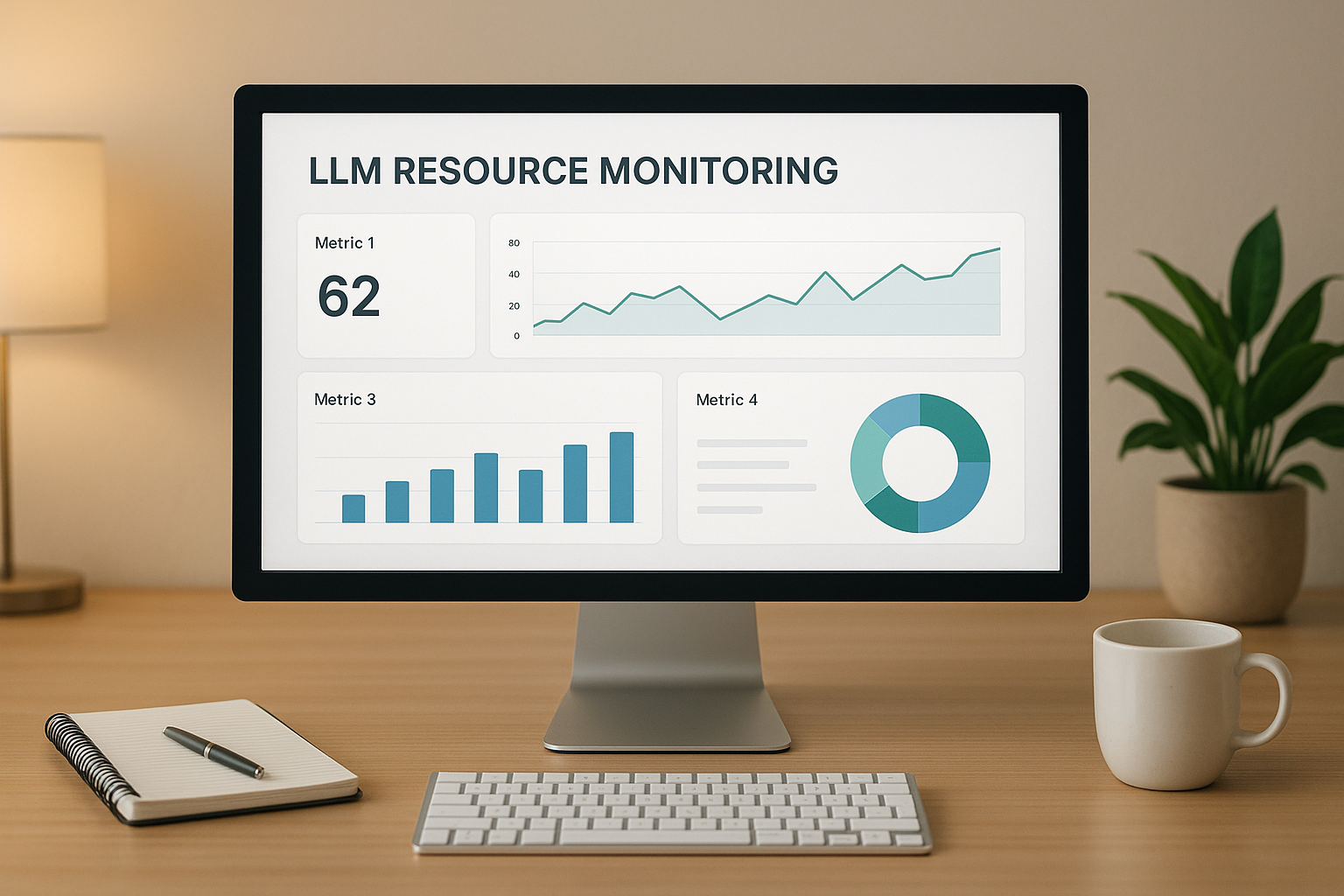
.png)
